SLDS162B March 2009 – December 2015 TLC59108F
PRODUCTION DATA.
- 1 Features
- 2 Applications
- 3 Description
- 4 Revision History
- 5 Pin Configuration and Functions
- 6 Specifications
- 7 Parameter Measurement Information
-
8 Detailed Description
- 8.1 Overview
- 8.2 Functional Block Diagram
- 8.3 Feature Description
- 8.4 Device Functional Modes
- 8.5 Programming
- 8.6
Register Maps
- 8.6.1 Control Register
- 8.6.2 Mode Register 1 (MODE1)
- 8.6.3 Mode Register 2 (MODE2)
- 8.6.4 Individual Brightness Control Registers (PWM0-PWM7)
- 8.6.5 Group Duty Cycle Control Register (GRPPWM)
- 8.6.6 Group Frequency Register (GRPFREQ)
- 8.6.7 LED Driver Output State Registers (LEDOUT0, LEDOUT1)
- 8.6.8 I2C Bus Sub-Address Registers 1 to 3 (SUBADR1-SUBADR3)
- 8.6.9 LED All Call I2C Bus Address Register (ALLCALLADR)
- 9 Application and Implementation
- 10Power Supply Recommendations
- 11Layout
- 12Device and Documentation Support
- 13Mechanical, Packaging, and Orderable Information
8 Detailed Description
8.1 Overview
The TLC59108F is an I2C bus controlled 8-bit LED driver optimized for red, green, blue, or amber (RGBA) color-mixing applications. Each LED output has its own 8-bit resolution (256 steps) fixed frequency individual PWM controller that operates at 97 kHz with a duty cycle that is adjustable from 0% to 99.6% to allow the LED to be set to a specific brightness value. An additional 8-bit resolution (256 steps) group PWM controller has both a fixed frequency of 190 Hz and an adjustable frequency between 24 Hz to once every 10.73 seconds with a duty cycle that is adjustable from 0% to 99.6% that is used to either dim or blink all LEDs with the same value.
Each LED output can be off, on (no PWM control), set at its individual PWM controller value or at both individual and group PWM controller values. The TLC59108F operates with a supply voltage range of 3 V to 5.5 V and the outputs are 17-V tolerant. LEDs can be directly connected to the TLC59108F device outputs.
Software programmable LED group and three sub call I2C bus addresses allow all or defined groups of TLC59108F devices to respond to a common I2C bus address, allowing for example, all the same color LEDs to be turned on or off at the same time or marquee chasing effect, thus minimizing I2C bus commands.
Four hardware address pins allow up to 14 devices on the same bus.
The software reset (SWRST) call allows the master to perform a reset of the TLC59108F through the I2C bus, identical to the power-on reset (POR) that initializes the registers to their default state causing the outputs to be set high (LED off). This allows an easy and quick way to reconfigure all device registers to the same condition.
8.2 Functional Block Diagram
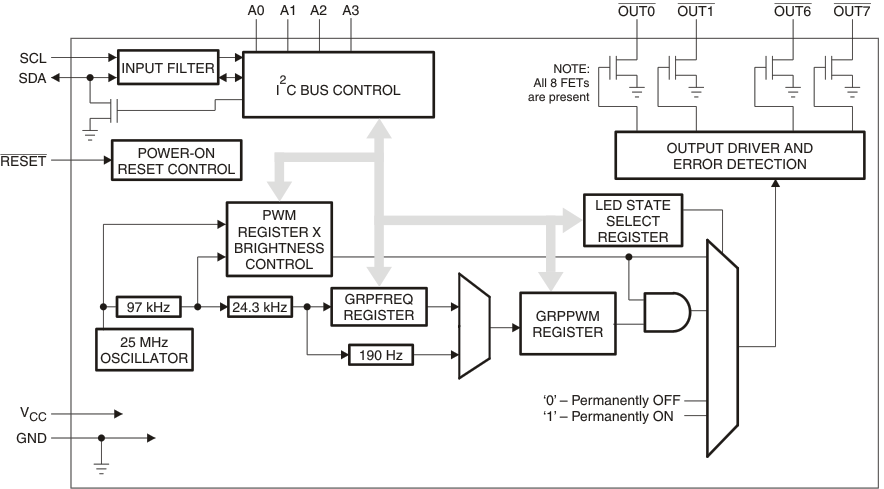
8.3 Feature Description
8.3.1 Power-On Reset
When power is applied to VCC, an internal power-on reset holds the TLC59108F in a reset condition until VCC has reached VPOR. At this point, the reset condition is released and the TLC59108F registers and I2C bus state machine are initialized to their default states causing all the channels to be deselected. Thereafter, VCC must be lowered below 0.2 V to reset the device.
8.3.2 External Reset
A reset can be accomplished by holding the RESET pin low for a minimum of tW. The TLC59108F registers and I2C state machine will be held in their default state until the RESET input is once again high.
This input requires a pullup resistor to VCC if no active connection is used.
8.3.3 Software Reset
The Software Reset Call (SWRST Call) allows all the devices in the I2C bus to be reset to the power-up state value through a specific I2C bus command. To be performed correctly, the I2C bus must be functional and there must be no device hanging the bus.
The SWRST Call function is defined as the following:
- A Start command is sent by the I2C bus master.
- The reserved SWRST I2C bus address 1001 011 with the R/W bit set to 0 (write) is sent by the I2C bus master.
- The TLC59108F device(s) acknowledge(s) after seeing the SWRST Call address 1001 0110 (96h) only. If the R/W bit is set to 1 (read), no acknowledge is returned to the I2C bus master.
- Once the SWRST Call address has been sent and acknowledged, the master sends two bytes with two specific values (SWRST data byte 1 and byte 2):
- Byte1 = A5h: the TLC59108F acknowledges this value only. If byte 1 is not equal to A5h, the TLC59108F does not acknowledge it.
- Byte 2 = 5Ah: the TLC59108F acknowledges this value only. If byte 2 is not equal to 5Ah, the TLC59108F does not acknowledge it.
- Once the correct two bytes (SWRST data byte 1 and byte 2 only) have been sent and correctly acknowledged, the master sends a Stop command to end the SWRST Call. The TLC59108F then resets to the default value (power-up value) and is ready to be addressed again within the specified bus free time (tBUF).
If more than two bytes of data are sent, the TLC59108F does not acknowledge any more.
The I2C bus master may interpret a non-acknowledge from the TLC59108F (at any time) as a SWRST Call Abort. The TLC59108F does not initiate a reset of its registers. This happens only when the format of the Start Call sequence is not correct.
8.3.4 Individual Brightness Control With Group Dimming or Blinking
A 97-kHz fixed frequency signal with programmable duty cycle (8 bits, 256 steps) is used to control individually the brightness for each LED.
On top of this signal, one of the following signals can be superimposed (this signal can be applied to the 4 LED outputs):
- A lower 190-Hz fixed frequency signal with programmable duty cycle (8 bits, 256 steps) is used to provide a global brightness control.
- A programmable frequency signal from 24 Hz to 1/10.73 s (8 bits, 256 steps) is used to provide a global blinking control.
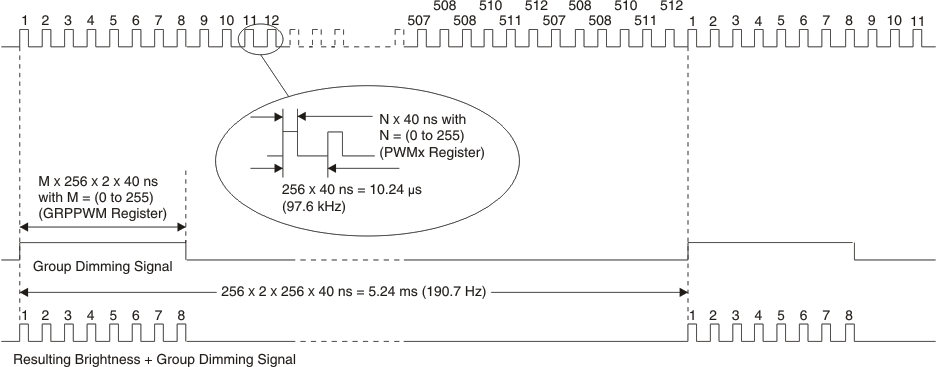
8.4 Device Functional Modes
Active - Active mode occurs when one or more of the output channels is enabled.
Standby - Standby mode occurs when all output channels are disabled. Standby mode may be entered either through I2C command or by pulling the RESET pin low.
8.5 Programming
8.5.1 Device Address
Following a Start condition, the bus master must output the address of the slave it is accessing.
8.5.2 Regular I2C Bus Slave Address
The I2C bus slave address of the TLC59108F is shown in Figure 8. To conserve power, no internal pullup resistors are incorporated on the hardware-selectable address pins, and they must be pulled high or low. For buffer management purpose, a set of sector information data should be stored.
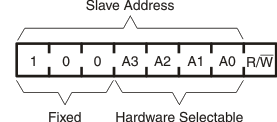 Figure 8. Slave Address
Figure 8. Slave Address
The last bit of the address byte defines the operation to be performed. When set to logic 1, a read operation is selected. When set to logic 0, a write operation is selected.
8.5.3 LED All Call I2C Bus Address
- Default power-up value (ALLCALLADR address register): 90h or 1001 000
- Programmable through I2C bus (volatile programming)
- At power-up, LED All Call I2C bus address is enabled. TLC59108F sends an ACK when 90h (R/W = 0) or 91h (R/W = 1) is sent by the master.
NOTE
The LED All Call I2C bus address (90h or 1001 000) must not be used as a regular I2C bus slave address since this address is enabled at power-up. All the TLC59108Fs on the I2C bus will acknowledge the address if sent by the I2C bus master.
8.5.4 LED Sub Call I2C Bus Address
- Three different I2C bus address can be used
- Default power-up values:
- SUBADR1 register: 92h or 1001 001
- SUBADR2 register: 94h or 1001 010
- SUBADR3 register: 98h or 1001 100
- Programmable through I2C bus (volatile programming)
- At power-up, Sub Call I2C bus address is disabled. TLC59108F does not send an ACK when 92h (R/W = 0) or 93h (R/W = 1) or 94h (R/W = 0) or 95h (R/W = 1) or 98h (R/W = 0) or 99h (R/W = 1) is sent by the master.
NOTE
The default LED Sub Call I2C bus address may be used as a regular I2C bus slave address as long as they are disabled.
8.5.5 Software Reset I2C Bus Address
The address shown in Figure 9 is used when a reset of the TLC59108F needs to be performed by the master. The software reset address (SWRST Call) must be used with R/W = 0. If R/W = 1, the TLC59108F does not acknowledge the SWRST. See Software Reset for more detail.
 Figure 9. Software Reset Address
Figure 9. Software Reset Address
NOTE
The Software Reset I2C bus address is a reserved address and cannot be use as a regular I2C bus slave address.
8.5.6 Characteristics of the I2C Bus
The I2C bus is for two-way two-line communication between different devices or modules. The two lines are a serial data line (SDA) and a serial clock line (SCL). Both lines must be connected to a positive supply through a pullup resistor when connected to the output stages of a device. Data transfer may be initiated only when the bus is not busy.
8.5.6.1 Bit Transfer
One data bit is transferred during each clock pulse. The data on the SDA line must remain stable during the high period of the clock pulse as changes in the data line at this time will be interpreted as control signals (see Figure 10).
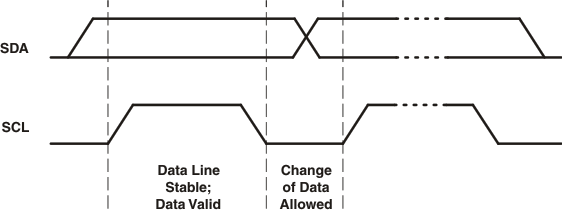 Figure 10. Bit Transfer
Figure 10. Bit Transfer
8.5.6.2 Start and Stop Conditions
Both data and clock lines remain high when the bus is not busy. A high-to-low transition of the data line while the clock is high is defined as the Start condition (S). A low-to-high transition of the data line while the clock is high is defined as the Stop condition (P) (see Figure 11).
 Figure 11. Start and Stop Conditions
Figure 11. Start and Stop Conditions
8.5.7 System Configuration
A device generating a message is a transmitter; a device receiving is the receiver. The device that controls the message is the master and the devices which are controlled by the master are the slaves (see Figure 12).
 Figure 12. System Configuration
Figure 12. System Configuration
8.5.8 Acknowledge
The number of data bytes transferred between the Start and the Stop conditions from transmitter to receiver is not limited. Each byte of eight bits is followed by one acknowledge bit. The acknowledge bit is a high level put on the bus by the transmitter, whereas the master generates an extra acknowledge related clock pulse.
A slave receiver which is addressed must generate an acknowledge after the reception of each byte. Also a master must generate an acknowledge after the reception of each byte that has been clocked out of the slave transmitter. The device that acknowledges has to pull down the SDA line during the acknowledge clock pulse, so that the SDA line is stable low during the high period of the acknowledge related clock pulse; set-up time and hold time must be taken into account.
A master receiver must signal an end of data to the transmitter by not generating an acknowledge on the last byte that has been clocked out of the slave. In this event, the transmitter must leave the data line high to enable the master to generate a Stop condition.
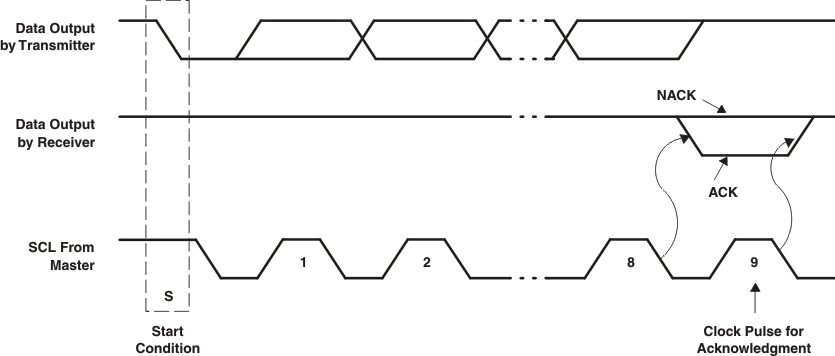 Figure 13. Acknowledge on I2C Bus
Figure 13. Acknowledge on I2C Bus
 Figure 14. Write to a Specific Register
Figure 14. Write to a Specific Register
 Figure 15. Write to All Registers Using Auto-Increment
Figure 15. Write to All Registers Using Auto-Increment
 Figure 16. Multiple Writes to Individual Brightness Registers Only Using the Auto-Increment Feature
Figure 16. Multiple Writes to Individual Brightness Registers Only Using the Auto-Increment Feature
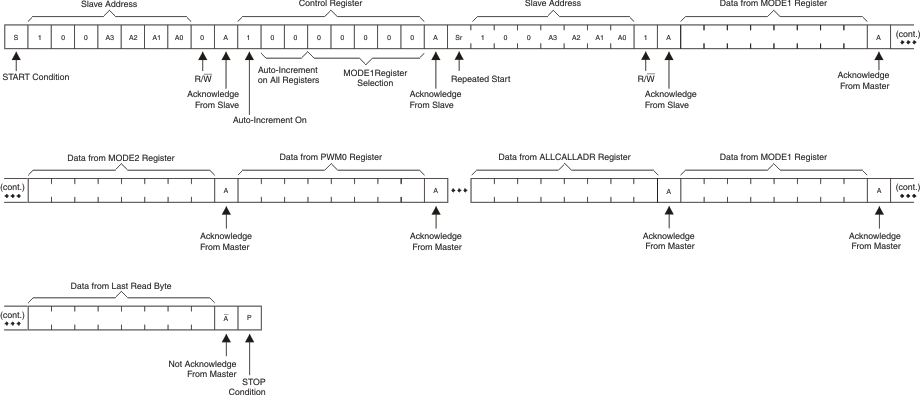 Figure 17. Read All Registers With the Auto-Increment Feature
Figure 17. Read All Registers With the Auto-Increment Feature
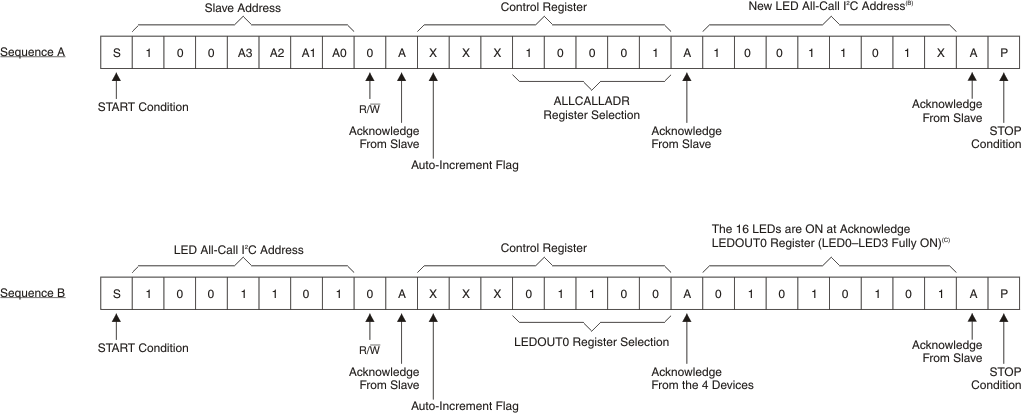
8.6 Register Maps
Table 2 describes the registers in the TLC59108F.
8.6.1 Control Register
Following the successful acknowledgment of the slave address, LED All Call address or LED Sub Call address, the bus master will send a byte to the TLC59108F, which will be stored in the Control register. The lowest 5 bits are used as a pointer to determine which register will be accessed (D[4:0]). The highest 3 bits are used as Auto-Increment flag and Auto-Increment options (AI[2:0]).
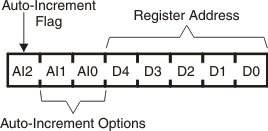 Figure 19. Control Register
Figure 19. Control Register
When the Auto-Increment flag is set (AI2 = logic 1), the five low order bits of the Control register are automatically incremented after a read or write. This allows the user to program the registers sequentially. Four different types of Auto-Increment are possible, depending on AI1 and AI0 values.
Table 1. Auto-Increment Options (1)
| AI2 | AI1 | AI0 | DESCRIPTION |
|---|---|---|---|
| 0 | 0 | 0 | No auto-increment |
| 1 | 0 | 0 | Auto-increment for all registers. D[4:0] roll over to 0 0000 after the last register (1 0001) is accessed. |
| 1 | 0 | 1 | Auto-increment for individual brightness registers only. D[4:0] roll over to 0 0010 after the last register (0 1001) is accessed. |
| 1 | 1 | 0 | Auto-increment for global control registers only. D[4:0] roll over to 0 1010 after the last register (0 1011) is accessed. |
| 1 | 1 | 1 | Auto-increment for individual and global control registers only. D[4:0] roll over to 0 0010 after the last register (0 1011) is accessed. |
AI[2:0] = 000 is used when the same register must be accessed several times during a single I2C bus communication, for example, changes the brightness of a single LED. Data is overwritten each time the register is accessed during a write operation.
AI[2:0] = 100 is used when all the registers must be sequentially accessed, for example, power-up programming.
AI[2:0] = 101 is used when the four LED drivers must be individually programmed with different values during the same I2C bus communication, for example, changing color setting to another color setting.
AI[2:0] = 110 is used when the LED drivers must be globally programmed with different settings during the same I2C bus communication, for example, global brightness or blinking change.
AI[2:0] = 111 is used when individually and global changes must be performed during the same I2C bus communication, for example, changing color and global brightness at the same time.
Only the 5 least significant bits D[4:0] are affected by the AI[2:0] bits.
When Control register is written, the register entry point determined by D[4:0] is the first register that will be addressed (read or write operation), and can be anywhere between 0 0000 and 1 0001 (as defined in Table 2). When AI[2] = 1, the Auto-Increment flag is set and the rollover value at which the point where the register increment stops and goes to the next one is determined by AI[2:0]. See Table 1 for rollover values. For example, if the Control register = 1110 1100 (ECh), then the register addressing sequence will be (in hex):
04 → … → 11 → 02 → ... → 11 → 02 → … as long as the master keeps sending or reading data.
Table 2. Register Descriptions
| REGISTER NUMBER (HEX) |
NAME | ACCESS (1) | DESCRIPTION |
|---|---|---|---|
| 00 | MODE1 | R/W | Mode register 1 |
| 01 | MODE2 | R/W | Mode register 2 |
| 02 | PWM0 | R/W | Brightness control LED0 |
| 03 | PWM1 | R/W | Brightness control LED1 |
| 04 | PWM2 | R/W | Brightness control LED2 |
| 05 | PWM3 | R/W | Brightness control LED3 |
| 06 | PWM4 | R/W | Brightness control LED4 |
| 07 | PWM5 | R/W | Brightness control LED5 |
| 08 | PWM6 | R/W | Brightness control LED6 |
| 09 | PWM7 | R/W | Brightness control LED7 |
| 0A | GRPPWM | R/W | Group duty cycle control |
| 0B | GRPFREQ | R/W | Group frequency |
| 0C | LEDOUT0 | R/W | LED output state 0 |
| 0D | LEDOUT1 | R/W | LED output state 1 |
| 0E | SUBADR1 | R/W | I2C bus sub-address 1 |
| 0F | SUBADR2 | R/W | I2C bus sub-address 2 |
| 10 | SUBADR3 | R/W | I2C bus sub-address 3 |
| 11 | ALLCALLADR | R/W | LED all call I2C bus address |
8.6.2 Mode Register 1 (MODE1)
Table 3 describes Mode Register 1.
Table 3. MODE1 – Mode Register 1 (Address 00h) Bit Description
| BIT | SYMBOL | ACCESS (1) | VALUE | DESCRIPTION |
|---|---|---|---|---|
| 7 | AI2 | R | 0 (1) | Register auto-increment disabled |
| 1 | Register auto-increment enabled | |||
| 6 | AI1 | R | 0 (1) | Auto-increment bit 1 = 0 |
| 1 | Auto-increment bit 1 = 1 | |||
| 5 | AI0 | R | 0 (1) | Auto-increment bit 0 = 0 |
| 1 | Auto-increment bit 0 = 1 | |||
| 4 | OSC | R/W | 0 | Normal mode (2) |
| 1 (1) | Oscillator off (3). | |||
| 3 | SUB1 | R/W | 0 (1) | Device does not respond to I2C bus sub-address 1. |
| 1 | Device responds to I2C bus sub-address 1. | |||
| 2 | SUB2 | R/W | 0 (1) | Device does not respond to I2C bus sub-address 2. |
| 1 | Device responds to I2C bus sub-address 2. | |||
| 1 | SUB3 | R/W | 0 (1) | Device does not respond to I2C bus sub-address 3. |
| 1 | Device responds to I2C bus sub-address 3. | |||
| 0 | ALLCALL | R/W | 0 | Device does not respond to LED All Call I2C bus address. |
| 1 (1) | Device responds to LED All Call I2C bus address. |
8.6.3 Mode Register 2 (MODE2)
Table 4 describes Mode Register 2.
Table 4. MODE2 – Mode Register 2 (Address 01h) Bit Description
| BIT | SYMBOL | ACCESS (1) | VALUE | DESCRIPTION |
|---|---|---|---|---|
| 7:6 | R | 0 (1) | Reserved | |
| 5 | DMBLNK | R/W | 0 (1) | Group control = dimming |
| 1 | Group control = blinking | |||
| 4 | R | 0 (1) | Reserved | |
| 3 | OCH | R/W | 0 (1) | Outputs change on Stop command (2). |
| 1 | Outputs change on ACK. | |||
| 2:0 | R | 000 (1) | Reserved |
8.6.4 Individual Brightness Control Registers (PWM0–PWM7)
Table 5 describes the Individual Brightness Control Registers.
Table 5. PWM0–PWM7 – Individual Brightness Control Registers (Addresses 02h–09h) Bit Description
| ADDRESS | REGISTER | BIT | SYMBOL | ACCESS (1) | VALUE | DESCRIPTION |
|---|---|---|---|---|---|---|
| 02h | PWM0 | 7:0 | IDC0[7:0] | R/W | 0000 0000 (1) | PWM0 individual duty cycle |
| 03h | PWM1 | 7:0 | IDC1[7:0] | R/W | 0000 0000 (1) | PWM1 individual duty cycle |
| 04h | PWM2 | 7:0 | IDC2[7:0] | R/W | 0000 0000 (1) | PWM2 individual duty cycle |
| 05h | PWM3 | 7:0 | IDC3[7:0] | R/W | 0000 0000 (1) | PWM3 individual duty cycle |
| 06h | PWM4 | 7:0 | IDC4[7:0] | R/W | 0000 0000 (1) | PWM4 individual duty cycle |
| 07h | PWM5 | 7:0 | IDC5[7:0] | R/W | 0000 0000 (1) | PWM5 individual duty cycle |
| 08h | PWM6 | 7:0 | IDC6[7:0] | R/W | 0000 0000 (1) | PWM6 individual duty cycle |
| 09h | PWM7 | 7:0 | IDC7[7:0] | R/W | 0000 0000 (1) | PWM7 individual duty cycle |
A 97-kHz fixed-frequency signal is used for each output. Duty cycle is controlled through 256 linear steps from 00h (0% duty cycle = LED output off) to FFh (99.6% duty cycle = LED output at maximum brightness). Applicable to LED outputs programmed with LDRx = 10 or 11 (LEDOUT0 and LEDOUT1 registers).
duty cycle = 
8.6.5 Group Duty Cycle Control Register (GRPPWM)
Table 6 describes the Group Duty Cycle Control Register .
Table 6. GRPPWM – Group Duty Cycle Control Register (Address 0Ah) Bit Description
| ADDRESS | REGISTER | BIT | SYMBOL | ACCESS (1) | VALUE | DESCRIPTION |
|---|---|---|---|---|---|---|
| 0Ah | GRPPWM | 7:0 | GDC0[7:0] | R/W | 1111 1111 (1) | GRPPWM register |
When DMBLNK bit (MODE2 register) is programmed with logic 0, a 190-Hz fixed frequency signal is superimposed with the 97-kHz individual brightness control signal. GRPPWM is then used as a global brightness control allowing the LED outputs to be dimmed with the same value. The value in GRPFREQ is then a Don’t care.
General brightness for the 8 outputs is controlled through 256 linear steps from 00h (0% duty cycle = LED output off) to FFh (99.6% duty cycle = maximum brightness). Applicable to LED outputs programmed with LDRx = 11 (LEDOUT0 and LEDOUT1 registers).
When DMBLNK bit is programmed with logic 1, GRPPWM and GRPFREQ registers define a global blinking pattern, where GRPPWM and GRPFREQ registers define a global blinking pattern, where GRPFREQ contains the blinking period (from 24 Hz to 10.73 s) and GRPPWM the duty cycle (ON/OFF ratio in %).

8.6.6 Group Frequency Register (GRPFREQ)
Table 7 describes the Group Frequency Register.
Table 7. GRPFREQ – Group Frequency Register (Address 0Bh) Bit Description
| ADDRESS | REGISTER | BIT | SYMBOL | ACCESS (1) | VALUE | DESCRIPTION |
|---|---|---|---|---|---|---|
| 0Bh | GRPFREQ | 7:0 | GFRQ[7:0] | R/W | 0000 0000 (1) | GRPFREQ register |
GRPFREQ is used to program the global blinking period when DMBLNK bit (MODE2 register) is equal to 1. Value in this register is a Don’t care when DMBLNK = 0. Applicable to LED output programmed with LDRx = 11 (LEDOUT0 and LEDOUT1 registers).
Blinking period is controlled through 256 linear steps from 00h (41 ms, frequency 24 Hz) to FFh (10.73 s).

8.6.7 LED Driver Output State Registers (LEDOUT0, LEDOUT1)
Table 8 describes the LED Driver Output State Registers.
Table 8. LEDOUT0 and LEDOUT1 – LED Driver Output State Registers (Address 0Ch and 0Dh) Bit Descriptions
| ADDRESS | REGISTER | BIT | SYMBOL | ACCESS (1) | VALUE | DESCRIPTION |
|---|---|---|---|---|---|---|
| 0Ch | LEDOUT0 | 7:6 | LDR3[1:0] | R/W | 00 (1) | LED3 output state control |
| 5:4 | LDR2[1:0] | 00 (1) | LED2 output state control | |||
| 3:2 | LDR1[1:0] | 00 (1) | LED1 output state control | |||
| 1:0 | LDR0[1:0] | 00 (1) | LED0 output state control | |||
| 0Dh | LEDOUT1 | 7:6 | LDR7[1:0] | R/W | 00 (1) | LED7 output state control |
| 5:4 | LDR6[1:0] | 00 (1) | LED6 output state control | |||
| 3:2 | LDR4[1:0] | 00 (1) | LED5 output state control | |||
| 1:0 | LDR4[1:0] | 00 (1) | LED4 output state control |
LDRx = 00 : LED driver x is off (default power-up state).
LDRx = 01 : LED driver x is fully on (individual brightness and group dimming and blinking not controlled).
LDRx = 10 : LED driver x is individual brightness can be controlled through its PWMx register.
LDRx = 11 : LED driver x is individual brightness and group dimming/blinking can be controlled through its PWMx register and the GRPPWM registers.
8.6.8 I2C Bus Sub-Address Registers 1 to 3 (SUBADR1–SUBADR3)
Table 9 describes the Output Gain Control Register.
Table 9. SUBADR1–SUBADR3 – I2C Bus Sub-Address Registers 1 to 3 (Addresses 0Eh–10h) Bit Descriptions
| ADDRESS | REGISTER | BIT | SYMBOL | ACCESS (1) | VALUE | DESCRIPTION |
|---|---|---|---|---|---|---|
| 0Eh | SUBADR1 | 7:5 | A1[7:5] | R | 100 (1) | Reserved |
| 4:1 | A1[4:1] | R/W | 1001 (1) | I2C bus sub-address 1 | ||
| 0 | A1[0] | R | 0 (1) | Reserved | ||
| 0Fh | SUBADR2 | 7:5 | A2[7:5] | R | 100 (1) | Reserved |
| 4:1 | A2[4:1] | R/W | 1010 (1) | I2C bus sub-address 2 | ||
| 0 | A2[0] | R | 0 (1) | Reserved | ||
| 10h | SUBADR3 | 7:5 | A3[7:5] | R | 100 (1) | Reserved |
| 4:1 | A3[4:1] | R/W | 1100 (1) | I2C bus sub-address 3 | ||
| 0 | A3[0] | R | 0 (1) | Reserved |
Sub-addresses are programmable through the I2C bus. Default power-up values are 92h, 94h, 98h and the device(s) will not acknowledge these addresses right after power-up (the corresponding SUBx bit in MODE1 register is equal to 0).
Once sub-addresses have been programmed to their right values, SUBx bits need to be set to 1 in order to have the device acknowledging these addresses (MODE1 register).
Only the 7 MSBs representing the I2C bus sub-address are valid. The LSB in SUBADRx register is a read-only bit (0).
When SUBx is set to 1, the corresponding I2C bus sub-address can be used during either an I2C bus read or write sequence.
8.6.9 LED All Call I2C Bus Address Register (ALLCALLADR)
Table 10 describes the LED All Call I2C Bus Address Register.
Table 10. ALLCALLADR – LED All Call I2C Bus Address Register Addresses 11h) Bit Description
| ADDRESS | REGISTER | BIT | SYMBOL | ACCESS (1) | VALUE | DESCRIPTION |
|---|---|---|---|---|---|---|
| 11h | ALLCALLADR | 7:5 | AC[7:5] | R | 100 (1) | Reserved |
| 4:1 | AC[4:1] | R/W | 1000 (1) | ALLCALL I2C bus address | ||
| 0 | AC[0] | R | 0 (1) | Reserved |
The LED All Call I2C-bus address allows all the TLC59108Fs in the bus to be programmed at the same time (ALLCALL bit in register MODE1 must be equal to 1 (power-up default state)). This address is programmable through the I2C-bus and can be used during either an I2C-bus read or write sequence. The register address can also be programmed as a Sub Call.
Only the 7 MSBs representing the All Call I2C-bus address are valid. The LSB in ALLCALLADR register is a read-only bit (0).
If ALLCALL bit = 0 (MODE1 register), the device does not acknowledge the address programmed in register ALLCALLADR.